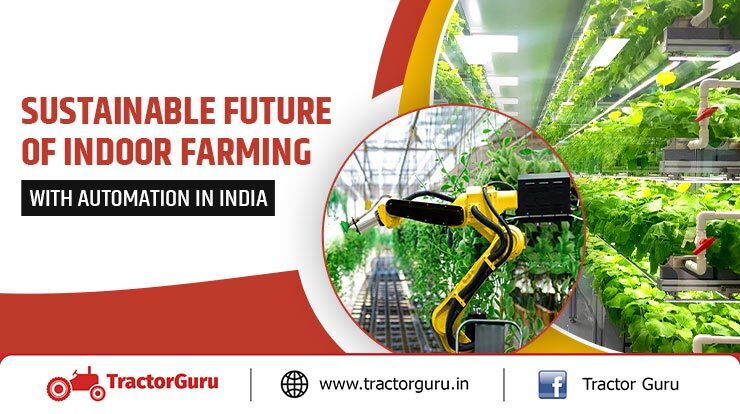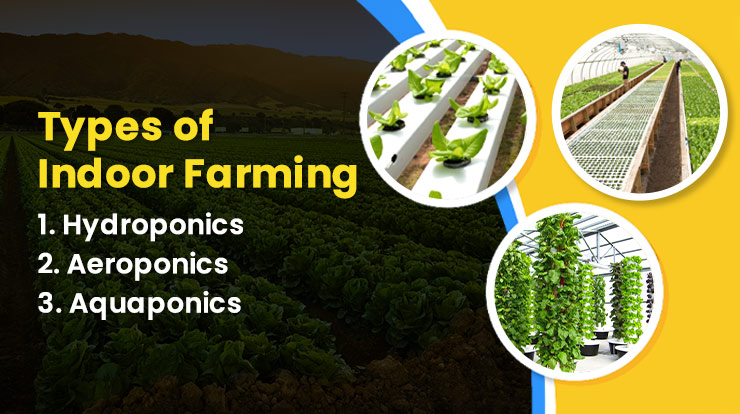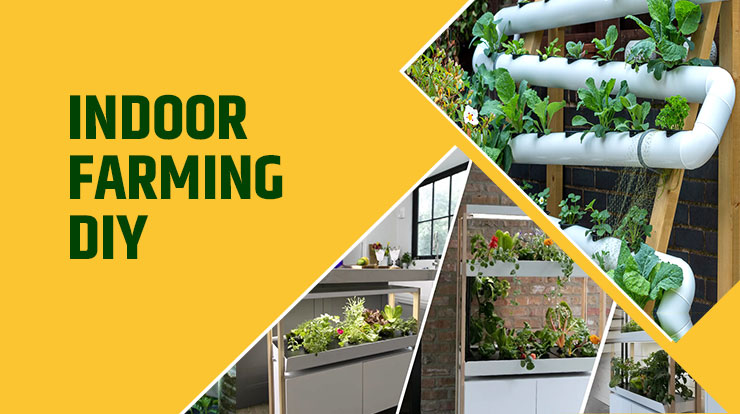Sustainable Future of Indoor Farming With Automation in India

Increasing population, uncontrolled environment and rapidly growing demand make sustainability more critical. And in this case, conventional farming replaces vertical indoor farming, which covers less space, does not require arable land, and provides quality and healthy food. So, here we are showing the benefits of modern indoor farming and making you aware of its benefits. But, before starting the details, firstly you should know about indoor farming which you check in the further blog.
What is Indoor Farming?
Indoor farming is also a part of agriculture, but the difference is, it is done indoors. It is a method of growing crops, fruits, vegetables, whether it is large scale or small scale, but happens entirely indoors. The indoor farming method oftenly considers hydroponic, aquaponic and aeroponic. These all types are done by using artificial lights to plants that provide nutrients and levels required for growth. It mainly considers vertical farming, which is also commonly said to be urban farming.
The concept of indoor cultivation, mainly vertical farming, was started in 1999 by Professor Dickson Despommier. His concept was to start indoor urban farming itself in less space and less time and saving time and cost that it takes to bring vegetables from rural areas to cities.
A few years ago, some wealthy countries started to join the vertical farming industry, and they were ready to take over the market. Then, for the first time, in Kuwait, the NOX management has opened large-scale vertical farming that can produce more than half-ton of leafy green vegetables.
Benefits of Indoor Farming
Everything has its own benefits, which makes them different from the crowd. Likewise, here we have the benefits of indoor farming, which shows you its importance and why should you choose? The advantages of this farming helps you to understand easily about it and gives you the reason to adopt it.
1. Year-round crop production
It is one of the biggest benefits, which is independent and not dependent on weather. You can grow any crop because of its year-round crop production, which you can plant without worrying about adverse climatic conditions. It can also produce crops of good quality and quantity and also lead to smart indoor farming.
2. Prevents by adverse weather conditions
You can grow crops in a fully climatic controlled environment, and it eradicates no need to rely on the climate to produce the plants. This indoor vertical, hydroponic, and aquaponic farming provides 100% consistency on producing food items and provides full harvesting certainty.
3. Better use of space
As we know, traditional farming requires fertile arable land. But, on the other side, vertical farming can be done in any climate and location because of its artificial substances. However, it is mainly done indoors, and an indoor vertical farming system which is a part of modern agriculture, requires less space and better utilisation of space.
4. Less usage of water
One of the main benefits of vertical farming is that it is a part of hydroponic farming. This hydroponic system requires only 10% of water to grow crops in the vertical farming method. Compared to traditional farming, vertical farming is more reliable nowadays because of water scarcity and requires less water. Moreover, the water can be reused after usage in vertical farming.
5. Suitable to Environment
This farming system proves good for the environment because of its highly reduced consumption of fuels and chemicals used by the farming equipment. The aim of indoor farming technology is to increase and improve biodiversity without interruption of land surface disturbance. This technology helps the lives of natural habitats that used to live around farms to be nurtured.
6. Reduce transport costs
Every food production needs the last-mile delivery, which is usually the most expensive part of supply or transport.
You should grow food nearer to where the consumer lives is a massive vertical farming benefit. It can highly reduce transportation costs, CO2 emissions and reduce the need for refrigerated storage.
7. Requires High energy & reduce injuries
It products require high energy with an adequate amount of power to achieve optimum growth. You can start smart indoor farming in India with many automated technologies.
Indoor agriculture mainly reduces the risk of injury and makes a safe workplace. Its equipment does not require heavy machinery or chemicals and prevents occupational hazards.
8. Reduce labour costs
Although fully automated indoor farming systems do not need a huge quantity of manual labour to get a year-round production. But sometimes, low-skilled labourers are hired to pack products and fulfil after harvesting processes. That’s why this process reduces labour costs. By following such tips you can make the most profitable indoor farming and can get an optimum profit value.
With the help of these benefits, you can also start commercial, large scale and small scale farming as well. In addition, by executing indoor agriculture technology, you can start a successful high tech indoor farming.
Types of Indoor Farming
There are many types of indoor farming, but all the categories are divided into three types which is 1) Hydroponic, 2) Aeroponic, and 3) Aquaponic. We have mentioned below all the three types, which will definitely help you to understand easily.

1. Hydroponics
Indoor hydroponic farming is a technique of producing plants without soil. In this system, the roots of plants grow by merging in the liquid solutions that contain nitrogen, phosphorus, sulphur, potassium, calcium, and magnesium. In addition, soil substitutes are also given to provide support for the roots in indoor vertical hydroponic farming, such as sand, gravel and sawdust.
It has many advantages that include the ability to increase productivity per area and requires less water usage. As a result, indoor farming hydroponics is the most prominent system that is used in vertical farms.
2. Aeroponics
Aeroponics is one of the most predominant farming systems that does not require any liquid or solid things to grow plants. Because the liquid nutrients are already misted in the chambers where the plants are fitted. The Aeroponics farming system is the most sustainable soil, and liquid less plant growing technique as it requires 90% less water. The invention of aeroponics was initiated by NASA, to find an efficient way to grow plants in space. It is now widely applied to vertical farming.
3. Aquaponics
It is a connection between plants and fishes that helps to grow plants. The term aquaponics originated from aquaponics which is close to the fish environment.
Why is the Future of Indoor Farming Sustainable?
It mainly incorporates controlled-environment agriculture that only aims to optimize plant growth without soil and water, such as hydroponics, aquaponics and aeroponics. Commonly the structures of indoor agriculture vertical farming are used in buildings, containers, tunnels, and an abandoned mine shaft.
Because traditional agriculture is extensively dependent on natural resources that require approximately 55% of non-forest land, 80% of total water, and 30% of fuel. But existing indoor agriculture practices lead to becoming more sustainable. Because the assumption says that the grocery demand will increase to 9% by 2025 market and it will require the prepared market to fulfil the grocery demands which should be considered in premium such as quality and safety.
Indoor Farming DIY

You can start DIY (Do it yourself) by using appropriate grow lights that plants require. If you are new to starting a veggie garden, start with easier growing plants such as lettuce, herbs, tomatoes and leafy plants.
Vertical farming is a method of growing leafy vegetables like spinach, mint, kale, basil and some plants like tomatoes, strawberries and many more. Because these kinds of plants do not require arable land, they can grow vertically indoors in PVC pipes.
We know, to start at home you cannot use a skyscraper or large storey buildings. But you can choose some scrap materials from your home and make the best from waste. You can also make your garden walls more beautiful by growing indoor vertical farming.
You can make indoor farming DIYs like:-
- Grow in containers, glass, jars & pipes.
- Setup a small frame of a greenhouse and indoor microgreen farm.
- Create fencing of plants and start yard indoor farming
- Use scrap bottles and make a chain.
- Make a micro wall of plants that covers less space.
- Start indoor organic farming
And so many ideas are available that you can follow at your home and execute. To check more blogs regarding farming stay tuned with TractorGuru.
Related Posts:



